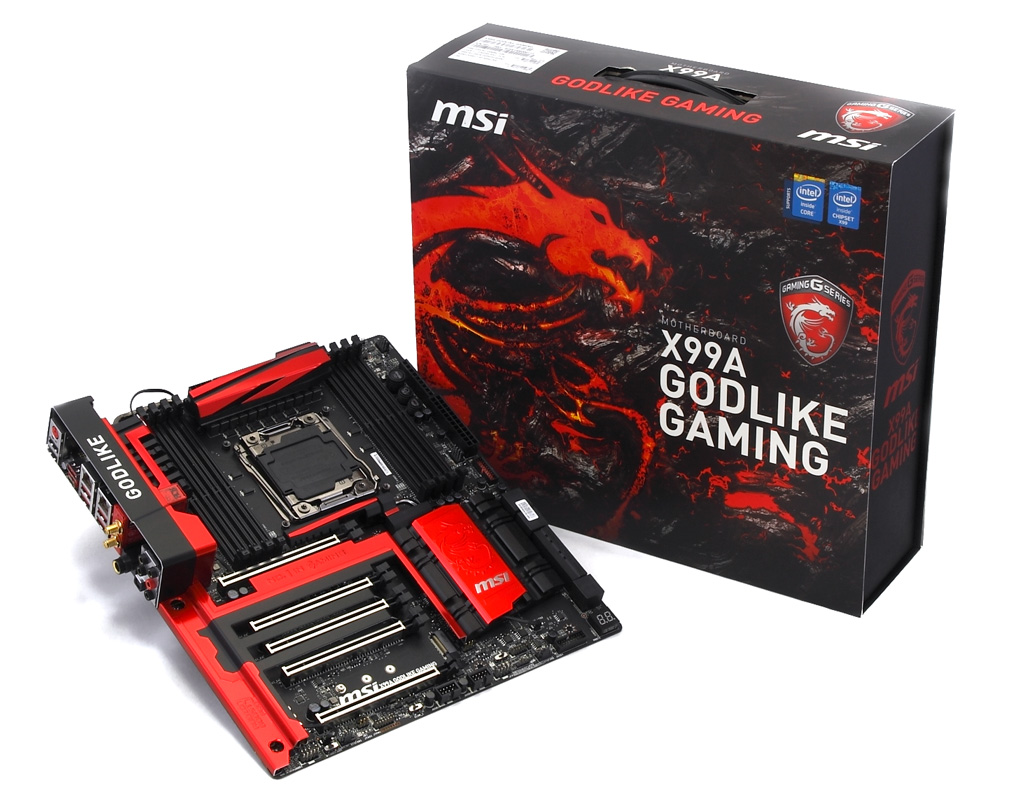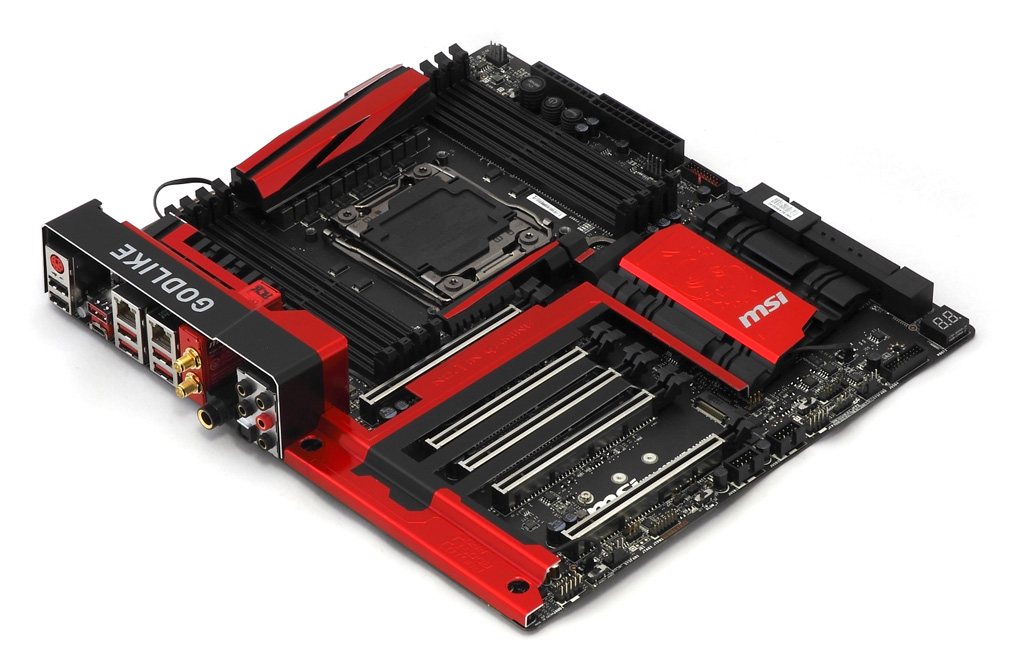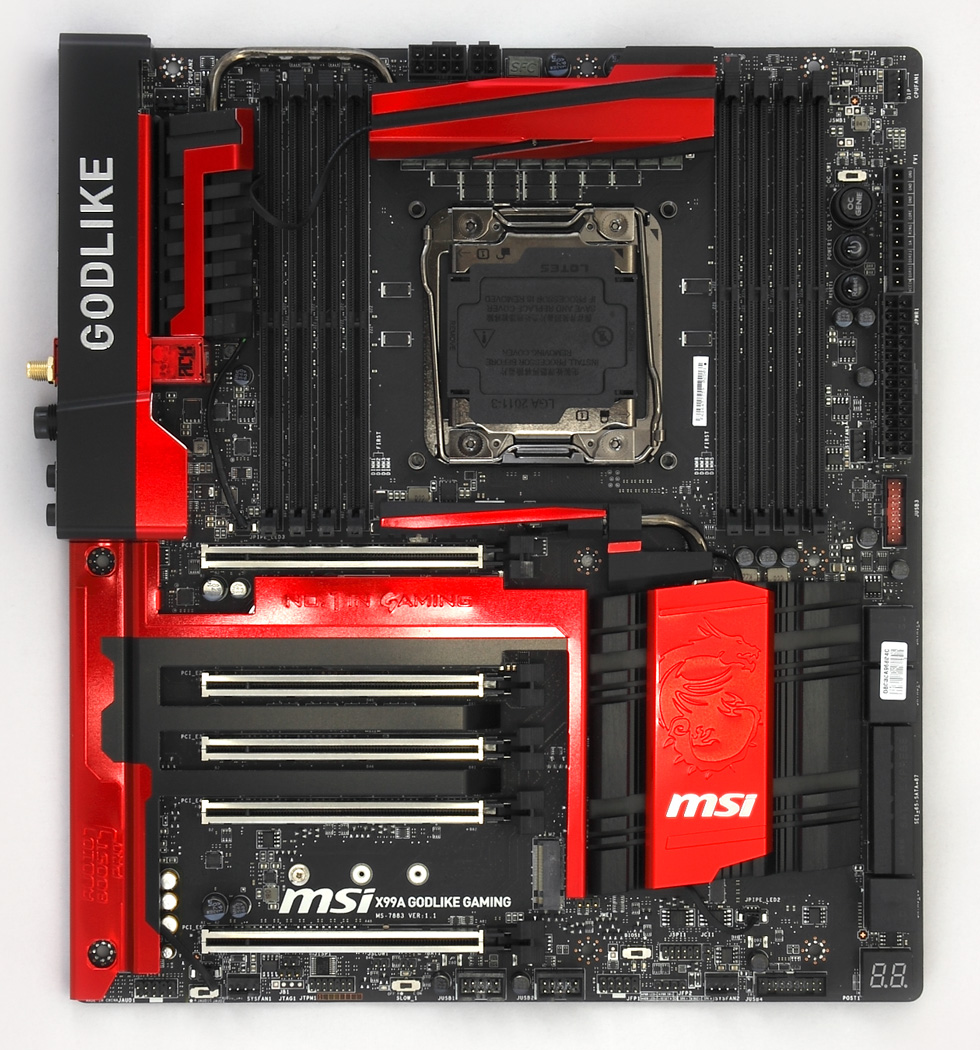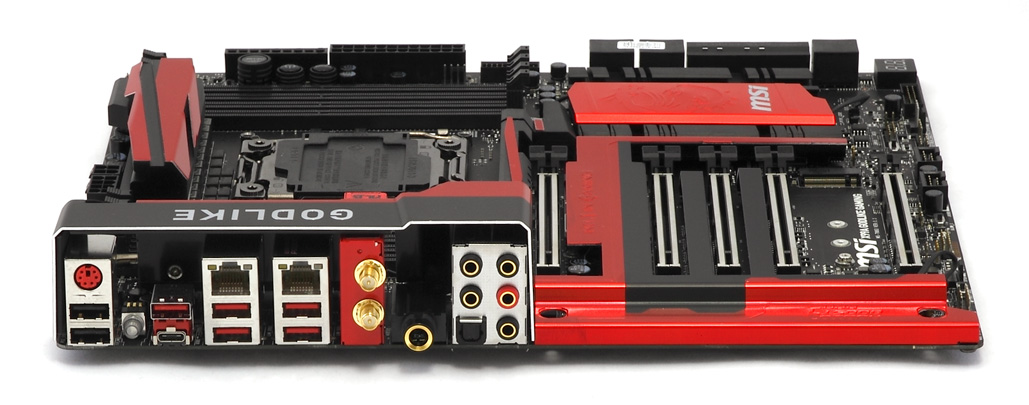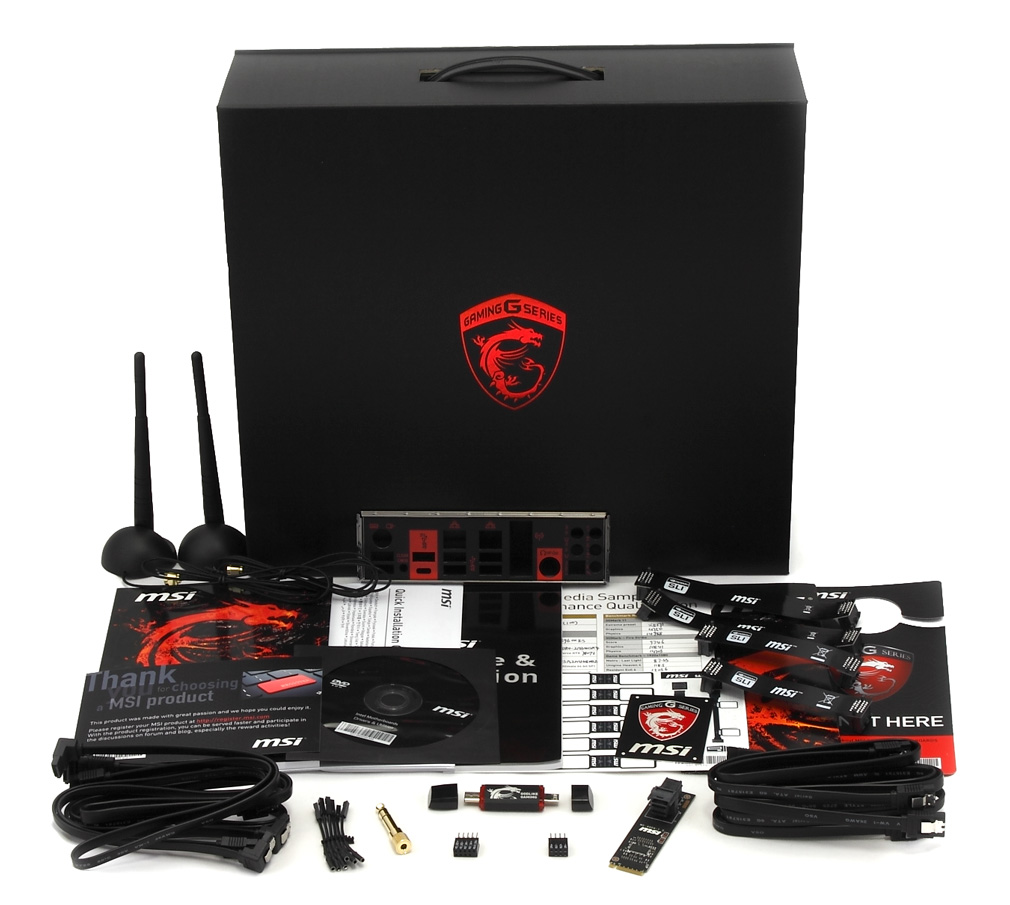Early Verdict
As of this writing, MSI's X99A Godlike Gaming ATX Motherboars is the premier X99 board that has come across the Tom's Hardware review desk.
Pros
- +
4-way SLI on 40-lane CPUs
- +
Superb CPU and RAM overclocking abilities
- +
USB 3.1 Gen 2 ports
- +
USB type-C, 3.0 x4 M.2 slot with NVMe
- +
Excellent networking
- +
Premium audio components
- +
RGB lighting
Cons
- -
Stunted M.2 with 3- and 4-way GPUs on 40-lane CPUs
- -
Higher power draw
- -
No DTS-Connect
Why you can trust Tom's Hardware
In Search Of The Divine
I call myself a practical enthusiast. I love seeing new technology advances, but in the end I always ask myself if I or others will actually be able to afford and use them. This means my exposure to top-shelf tech usually results in a lot of drool, but few purchases. Like most people on a limited budget, component performance value is the most important aspect for me when building a computer. While I can sometimes spend a little extra money for a CPU or GPU, budget constraints almost always dictate I use a solid but unassuming mainstream motherboard in my personal systems. So what am I supposed to think about a motherboard that retails for more than a whole office PC?
The drooling tech enthusiast in me is a bit in awe and wonder. The budget conscientious cynic in me asks what benefits could possibly be worth the price tag. Let's find out which side is correct.
Specifications
MORE: Best MotherboardsMORE:
How To Choose A MotherboardMORE: All Motherboard Content
While I prefer understated rigs and cases, that doesn't mean I can't appreciate a good looking board. The Godlike's glossy crimson and silver accents pop against the flat black PCB. To protect the eye candy, the Godlike ships with adhesive plastic covering every decorative metal surface on the I/O shield, heat sinks and PCIe slot covers. MSI wasn't content with just fancy anodizing. The Godlike also features RGB lighting effects, which MSI calls Mystic Light. The lighting is controlled through a Windows application that lets you set static and cycling colors and pattern effects such and blinking, pulsing and lightning storm. You can also control the lighting through Bluetooth via an Android 4.0 application on a supported tablet or phone.
The Godlike packs its PCB full with circuitry and features. A 4-pin fan header can be found at each of the top corners. These headers are wisely designated in the BIOS for CPU use to support the massive dual-fan coolers that are often used on X99 systems. Between the fan headers are both 4- and 8-pin EPS plugs to make sure the CPU is well-supplied with power. Just below the power input is a 12-phase VRM using premium chokes. The VRM is topped by a thick heat sink that connects via nickel-plated heatpipe to a secondary fin stack just behind the I/O panel group. A small cable attaches just beside the left RAM slots and runs between the sinks to power the RGB lighting.
The top right edge has a cluster of bench-friendly buttons for power, reset and MSI's typical OC Genie control. The switch next to the OC Genie button controls the aggressiveness of the automatic overclock settings -- the manual calls it first and second gear. Next to the switch are blue and red LEDs to let you know what mode it's in. A third LED indicates whether XMP has been enabled in BIOS. Outside of the control buttons is a voltage detection header. Instead of just solder blobs on the board, MSI gives you header jacks and lead cables to easily and safely check the various voltage levels across the board.
The rest of the front edge is more mundane. Below the voltage detection bracket are 24-pin ATX power, 4-pin fan and a USB 3.1 gen1 headers. MSI's Super-Charger application enables this port to disable the data connection lines to supply more power for charging devices such as a phone or tablet. Under the USB is an array of 10 forward-facing SATA 6.0 Gbps ports and one SATA Express port that shares lanes with SATA ports 5 and 6. The bottom right corner has a debug display that also doubles as a CPU temperature readout once the system is fully booted.
Get Tom's Hardware's best news and in-depth reviews, straight to your inbox.
The HD audio header is in the bottom left corner next to an audio output switch. This switch toggles whether audio gets piped to the normal front panel connectors or the ¼-inch headphone jack on the rear I/O plate. The rest of the bottom is taken up by two USB 2.0 headers, a second USB 3.1 header, two more 4-pin fan headers, a TPM jack, chassis intrusion header, front panel header, BIOS selector switch and slow boot switch for extreme overclocking.
The rear I/O panel comes well-stocked with a PS/2 port and two USB 2.0 ports for keyboards and mice, a blue lit CMOS reset button, two USB 3.1 Gen2 ports (one type-C) and four USB 3.1 Gen1 ports. Killer networking provides dual Gigabit wired network jacks, two antenna hubs for the wireless networking and Bluetooth as well. All three network devices can be combined in what Killer calls DoubleShot-X3 Pro. A premium audio sub-system offers five analog audio jacks and one S/PDIF optical audio port while high quality amps power a ¼-inch headphone jack for high impedance audio devices.
All five slots on the Godlike are PCIe 3.0 and x16 length. They are also encased in what MSI calls Steel Armor. This involves extra solder points on the underside of the PCB and metal plating around the slots themselves. MSI claims this strengthens the slots to keep them from sagging, splitting, or otherwise getting damaged when using larger, heavier GPUs. The first, second, fourth and fifth slots are all double-spaced for optimal GPU spacing, but oddly MSI puts a single-spaced slot in the middle that can't be used as such. This slot isn't even listed in MSI's recommended SLI/CFX setup (covered below). My best guess is it can be used for other expansion cards when using two or fewer GPUs.
Between the first and second slot, under the thermal shield, is a separate Bluetooth controller for the RGB lighting. An M.2 slot sits between the fourth and fifth slots. The M.2 can operate in both SATA and 3.0 x4 modes and supports NVMe. It supports 42mm, 60mm and 80mm modules. Like many boards, the M.2 shares lanes with the SATA Express connector, so using M.2 in SATA mode will disable SATA Express and SATA ports 5 and 6.
While all the card slots are physically x16 in length, only the first and fourth slots are actually wired to all 16 lanes; the rest are left to 8 lanes and rely on lane switches to properly route the CPU's input as necessary. Like many X99 boards right now, the Godlike has a fairly complex way of splitting up the PCIe lanes between the card slots and other devices. Fortunately, the board is fully four-way SLI and CrossFireX certified when using a 40-lane CPU. Unfortunately, you still see a few head-scratchers here, even with that 40-lane CPU.
When using only one GPU, both the first and fourth slots will give you full 16-lane bandwidth. While seemingly odd to not place the GPU in the top slot, this allows extra clearance for particularly large air-coolers for the CPU (such as the NH-D15 on my test bed – indeed I couldn't have fit the 290X in otherwise). The first and fourth slots handle two-way GPUs, regardless of CPU, with the fourth slot dropping to 8 lanes with 28-lane CPUs (the first slot retains all 16 lanes). Three- and four-way graphics shakes things up.
First, let's examine the Godlike's behavior with a 28-lane CPU. A third GPU borrows 8 lanes from the first slot to fuel the second without changing any other connectivity. Adding a fourth card steals the four lanes from the M.2 slot for the fifth card slot. The M.2 falls back to the SATA Express controller's PCIe lanes through the chipset, meaning you can only run one or the other, but only at 2.0 x2 speeds. But since four-way SLI is such a rare use case with a 28-lane CPU, this is hardly an issue, especially since three-way leaves everything else untouched.
With 40-lane CPUs, the lane splitting is focused more on graphics than storage when going three- and four-way. The first and fourth slots retain all 16 lanes in any kind of graphic configuration with a 40-lane CPU. For the third card, instead of the second slot borrowing lanes, the fifth slot is used and given the CPU's remaining 8 lanes. This leaves the M.2 and SATA Express in the same situation as 28-lane four-way, meaning only 2.0 x2 connectivity through the chipset instead of the CPU and only one can be used. Four-way on 40-lane CPUs is much the same as three-way with 8 lanes getting duplicated to the second slot, but the M.2 and SATA Express stay in their predicament. The table below, pulled from the manual, illustrates this.
| MSI X99 Godlike PCIe Lane Splitting | |||||||||||
|---|---|---|---|---|---|---|---|---|---|---|---|
| CPU Lanes | 28 | 40 | |||||||||
| GPU Count | 1-Way | 2-Way | 3-Way | 4-Way | 1-Way | 2-Way | 3-Way | 4-Way | |||
| Slot 1 | 3.0 x16 | 3.0 x16 | 3.0 x8 | 3.0 x8 | 3.0 x16 | 3.0 x16 | 3.0 x16 | 3.0 x8 | |||
| Slot 2 | - | - | 3.0 x8 | 3.0 x8 | - | - | - | 3.0 x8 | |||
| Slot 4 | 3.0 x16* | 3.0 x8 | 3.0 x8 | 3.0 x8 | 3.0 x16* | 3.0 x16 | 3.0 x16 | 3.0 x16 | |||
| Slot 5 | - | - | - | 3.0 x4 | - | - | 3.0 x8 | 3.0 x8 | |||
| M.2 | 3.0 x4 | 3.0 x4 | 3.0 x4 | 2.0 x2 | - | 3.0 x4 | 3.0 x4 | 2.0 x2 | - | 2.0 x2 | - |
| SATA Express | 2.0 x2 | 2.0 x2 | 2.0 x2 | - | 2.0 x2 | 2.0 x2 | 2.0 x2 | - | 2.0 x2 | - | 2.0 x2 |
| * Slot 4 can also be used for a single GPU with all 16 lanes |
This is disappointing. Normally you'd think a motherboard would reward consumers that get premium parts. But when using three GPUs, it's arguable that users with lesser CPUs get better connectivity options since you retain the 3.0 x4 for the M.2 slot and can still use SATA Express. If anything, you'd think this would be the other way around. It's more understandable that four-way GPUs would disable some other devices, but even that is disappointing for a product marketed as "Godlike." Purists may disagree with me, but a four-way x8/x8/x8/x8 split that leaves the storage untouched would be preferable in my book.
The Godlike comes in premium packaging with a magnetic flap closure and lots of protection. Inside the large box are an installation CD, 8GB installation USB drive with both micro and type-C interfaces, a nicely detailed instruction manual, quick start user guide, padded I/O backplate shield, 10 SATA cables (five with angled heads), a page of adhesive cable labels, four flexible SLI bridges, M.2 to U.2 adapter card, two header quick connect risers, six voltage check extension leads, 3.5mm to 6.3mm headphone jack adapter, two WiFi antennas with external magnetic mounts, MSI branded case badge and a "Do Not Disturb" door hanger. That's a loaded box and I can't say anything is lacking.
-
Achaios "Godlike Gaming" You don't even need to read anything further to come to the conclusion that they are BS'ing you.Reply -
There is one major problem with this motherboard which renders entire package f. useless and that is Killer E2400 which simply sucks.Reply
-
elbert The latest bios version supports Broadwell-EP and seeing some on newegg. I wonder if MSI godlike would allow blk OC? I know Asrock did this for Skylake kin Xeons few months back so any chance of some tweaking? I see the Intel Xeon E5-2620 V4 8 core for $433 which could make this high priced board much more appealing.Reply -
3ogdy Godlike.... What's next? Bible-Z-Power? CondomStrength-X? P-Dow-Pope?Reply
MSI G-Zus' E-ster (-E-leezation)? The Sacredblood competing with Sabertooh?
Put a Devil's Canyon on a Pope's PowerLight 2016? Let's hope they won't have children.
MSI 6-5P0T? The FL35HL16HT 4 (in collaboration with) YO'MOMMA stick?
Introducing the new gaming seat from MSI: The Rectum Z! The ultimate X-perience!
FFS...
Seriously now,
What if I happen to have boot problems or lag while gaming on that motherboard? Does that mean GOD doesn't LIKE me?
What does it mean if there's a better board around? That God is gaming on bullshit hardware? I bet God can game better, right?
And isn't it strange that it's nothing but a GodLike motherboard that's using the 2 most typical colors from hell - red and black? Wasn't heaven supposed to be white and all that? -
RedJaron Reply
It's bold, probably overzealous marketing. But no worse than Republic of Gamers, K|NGP|N, or many other brandings. But names and branding don't return performance results like this. If MSI is BS'ing me with this, I could use some more BS.18018456 said:"Godlike Gaming" You don't even need to read anything further to come to the conclusion that they are BS'ing you.
I've seen problems with the 2200, especially on Linux, but not so much for the 2400. I didn't have a single problem with it in my testing.18018531 said:There is one major problem with this motherboard which renders entire package f. useless and that is Killer E2400 which simply sucks.
You're talking completely different platforms. Broadwell is simply a die shrink of Haswell. Skylake is only on the LGA1151 socket right now. We haven't seen the Skylake successor to LGA2011-3 yet.18018562 said:The latest bios version supports Broadwell-EP and seeing some on newegg. I wonder if MSI godlike would allow blk OC? I know Asrock did this for Skylake kin Xeons few months back so any chance of some tweaking? I see the Intel Xeon E5-2620 V4 8 core for $433 which could make this high priced board much more appealing.
If you dropped an E5v4 Xeon in here, yes, you could OC it using BCLK just like you could with all other Sandy Bridge, Ivy Bridge, or Haswell Xeons. However, Broadwell doesn't change the BCLK like Skylake does, so you'd likely only be able to get a 5% OC. -
Onus At $540 on Newegg, this board costs almost as much as a whole PC that would be a modest but competent gamer. I don't see one on my short list.Reply
-
RedJaron Reply
I made the exact same observation. Now I find myself making excuses at how my next computer needs to be X99. It's kind of like an SSD. Once you try one, it's hard to go back.18019057 said:At $540 on Newegg, this board costs almost as much as a whole PC that would be a modest but competent gamer. I don't see one on my short list.
. . . I think I need help, maybe an intervention. ;) -
elbert ReplyYou're talking completely different platforms. Broadwell is simply a die shrink of Haswell. Skylake is only on the LGA1151 socket right now. We haven't seen the Skylake successor to LGA2011-3 yet.
True but they both use microcode to control their defaults. I understand Intel fix their microcode to close the exploit in future Xeon V5. Due to defaults and thus micro code in the broadwell-LP has changed could their be exploits for board makers?
If you dropped an E5v4 Xeon in here, yes, you could OC it using BCLK just like you could with all other Sandy Bridge, Ivy Bridge, or Haswell Xeons. However, Broadwell doesn't change the BCLK like Skylake does, so you'd likely only be able to get a 5% OC.
I also hear a broadwell-ep 5.1Ghz E5-2602 V4 may be coming. -
turkey3_scratch Reply18018456 said:"Godlike Gaming" You don't even need to read anything further to come to the conclusion that they are BS'ing you.
Exactly - you didn't read anything. If you read the review, it's a very high quality board. -
joex444 That PCIe breakdown is awful. The switching of the M.2 slot to PCIe 2.0 x2 from 3.0 x4 would be unacceptable; buying the NVMe PCIe 3.0 x4 SSDs today is a premium purchase and anyone interested in that simply requires that it runs at 3.0 x4 - not 2.0 x2 (a mere quarter of the bandwidth). The fact with a 40-lane CPU you can only get 3.0 x4 M.2 working with 1 or 2 PCie cards is absurd even for a $200 board. The fact that a RAID controller operating with an x8 configuration counts as well means that you can have an M.2 NVMe 3.0 x4 SSD, an x8 RAID controller, and be unable to run SLI graphics. Unless you buy the cheaper 28 lane CPU - then you can have SLI, RAID, and NVMe 3.0 x4.Reply
The engineers who came up with this one probably were trying to get people who were considering the 5930K + $250 X99 board to consider the 5820K + $500 board - net cost is about the same, but clearly MSI would benefit more from the second purchase than the first.
